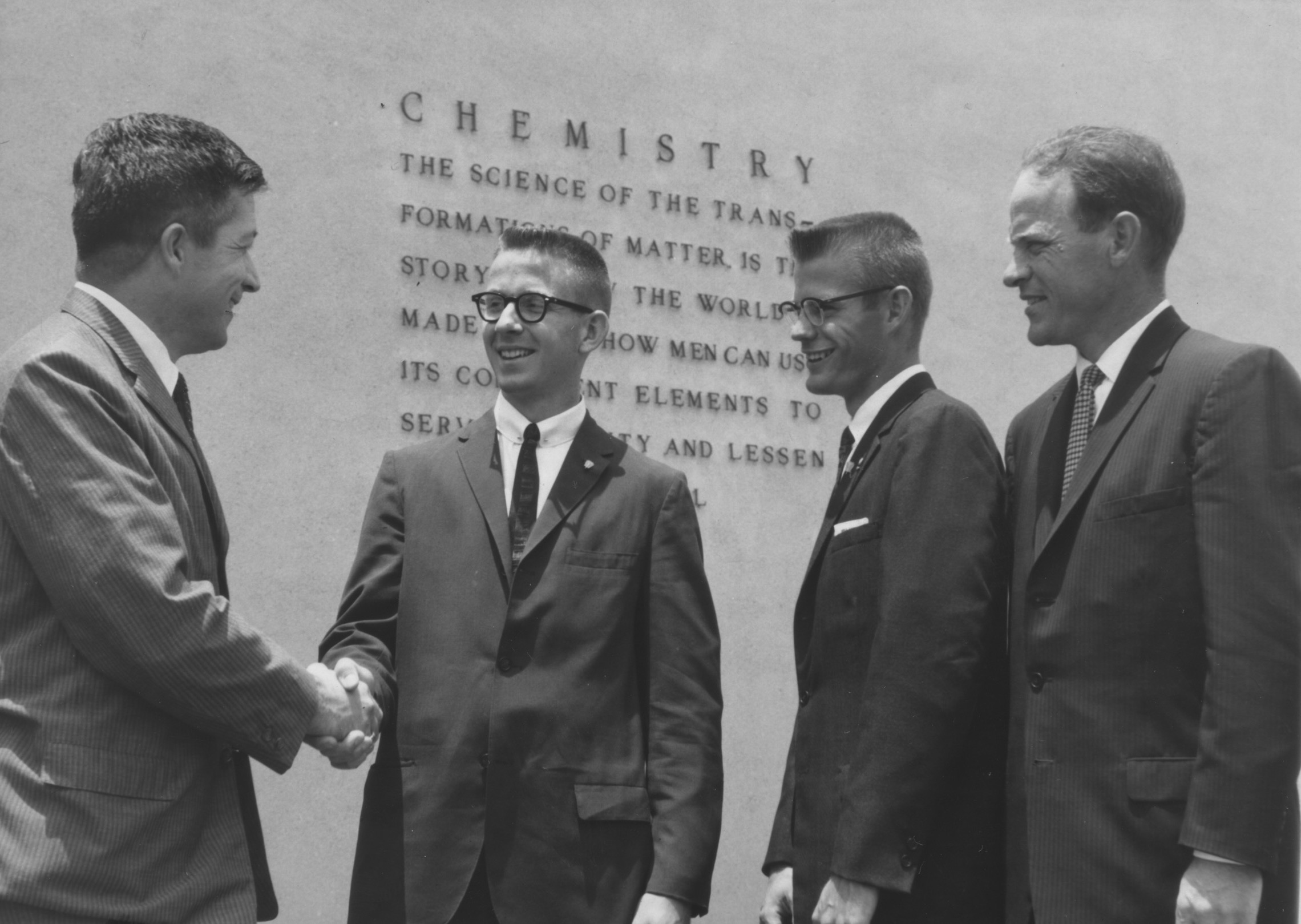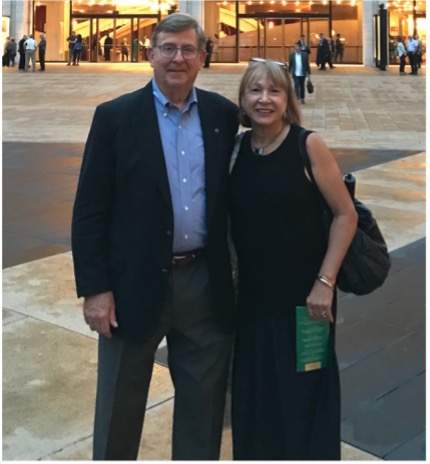Marc Loudon: A perfect harmony of music and chemistry

Marc Loudon (second from left) along with a representative from Dow and Prof. Hulen Williams, Department Head, at right (September 1960).
Born and raised in Baton Rouge, a young Marc Loudon was a talented pianist and an aspiring musician. However, a high school chemistry teacher from Baton Rouge High, Mr. Hargrove, encouraged Loudon to pursue chemistry in college. In 1960, Loudon graduated from Baton Rouge High and enrolled at Louisiana State University as a chemistry major.
Like many of his friends and classmates in high school, Loudon initially considered a pre-medicine track, but a Dow Chemistry Scholarship changed his career path. Loudon was a recipient of a $2,500 4-year scholarship. Although this amount doesn’t seem substantial to today’s cost of attendance, the scholarship generously covered his academic studies. Tuition cost during that time was around $15 per semester.
During his undergraduate studies in chemistry, Loudon was able to continue his passion for music. He served on the first LSU Union Board where he was the producer of LSU’s presentation of the Cole Porter musical "Kiss me, Kate." In addition, he was an accompanist for voice lessons in the music school and accompanied choral conducting classes and several concerts of the LSU A Capella choir under the musical mentorship of Professor Dallas Draper.
“In chemistry, we often think about a target—an end result—and formulate a process about how to get there. Most people think of music as something in which you start at the beginning and go to the end,” Loudon said. “But an equally viable way to compose, or to learn a piece, is to look at the overall concept and objective and then reason how to get there by working in reverse and not necessarily in order. I think my chemistry training directly influenced my ability to take this approach.”
In May 1963, Loudon received a national Chemical and Engineering News Merit Award for his extracurricular activities with music and being a successful undergraduate chemistry student.
Loudon has many fond memories and reflects on the guidance and mentorship he received from LSU faculty. “When I was at LSU, faculty were very concerned with their students,” Loudon said. “I recall a time when Professor Nauman looked at me and said, ‘I will teach you how to think, Loudon’… and he did.”
Loudon participated in an NSF Undergraduate Summer Research Program under the guidance of Department Chair and Professor Hulen Williams. He studied the mechanism of a reaction discovered in the Williams lab with infrared spectroscopy. It was this undergraduate research experience that motivated Loudon to pursue graduate studies.
Loudon graduated with a Bachelor of Science in chemistry in 1964 (Magna cum laude) and completed a summer internship with Dow. Following the advice of Professor Nauman, Loudon packed his bags and headed west to pursue a PhD at the University of California at Berkeley.
“I thought it would be fun to go to California. I went sight unseen. There was no website, just research publications to view. It was the only school I applied to and was lucky to be accepted,” said Loudon. “The program attracted students from very competitive schools, such as MIT, but I felt I had great preparation from LSU.”
Loudon earned his PhD in organic chemistry in 1968 under the guidance of Professor Donald S. Noyce. His dissertation was titled “Investigations of the Mechanisms of Carbon-Carbon Multiple Bond Protonation Reactions, and the Effects of Ortho Substituents.” He remained at UC Berkeley for postdoctoral research in Biochemistry from 1968-1970 with Professor Daniel E. Koshland, Jr.
In 1970, Loudon accepted an assistant professor of chemistry position at Cornell University. During his tenure at Cornell, Loudon’s research interests included carboxy-terminal peptide degradation, and site-specific peptide cleavage reactions.
"Research is often 11 steps forward and 10 steps back, but I found it thrilling to discover something—even a little something--that no one ever knew before." Loudon said. "This is a motivating force that never left me throughout my career, even though the things I and my students discovered were not in general earth-shattering."
After seven years at Cornell and being promoted to associate professor, Loudon transferred to the Department of Medicinal Chemistry and Pharmacognosy at Purdue University. In 1988, Loudon was appointed Associate Dean for Research and Graduate Programs for the College of Pharmacy, Nursing, and Health Sciences, a position in which he served for 19 years.

Dr. Marc Loudon and his wife Judy (September 2018).
While serving administrative duties, Loudon’s research interest shifted to science education, focusing on teaching and instruction and the utilization of group-learning techniques. With HHMI funding through the HHMI NEXUS project, Loudon develop a more biological relevant pre-health professions organic chemistry course. He developed and implemented group work strategies with a class of 250+ students in order to facilitate student engagement. In 1996, Purdue named him Distinguished Professor in recognition of his efforts in undergraduate education.
“Group learning techniques encourage students to share unique insights and learn from each other,” Loudon said. “One innovative approach I implemented were exams with a group and non-group portions. Students had to collaborate with each other to find the answers and explain how they got those answers, which provided essential skill building for their careers,” Loudon said.
Purdue's Quality Assurance program recognized Loudon's innovative instructional strategies that facilitated cooperative learning in large classroom settings. In 2000, Loudon was named Indiana Professor of the Year by the Carnegie Foundation for the Advancement of Teaching.
In July 2015, Loudon retired from Purdue University and moved to New Orleans, LA, with his wife, Judy. Loudon continues working with science education and is the co-author of Organic Chemistry, now in the 7th edition with Macmillan, and is also the co-author of the Study Guide and Solutions Manual to accompany that text. When he is not working on his textbook writing, Loudon enjoys visiting family, playing pickleball, and serving as the assistant organist of Christ Church Cathedral.
Gretchen Schneider | October 14, 2021